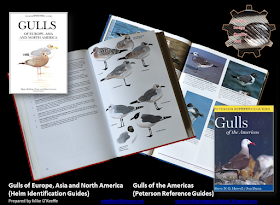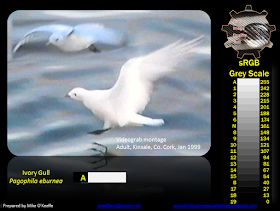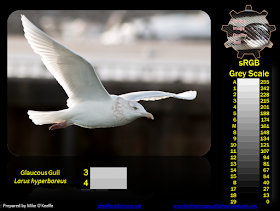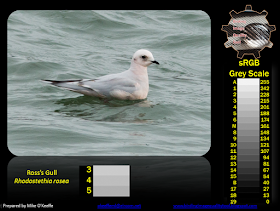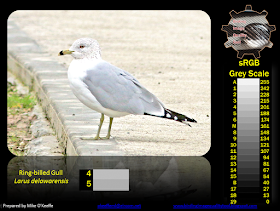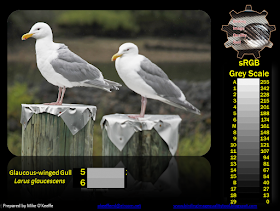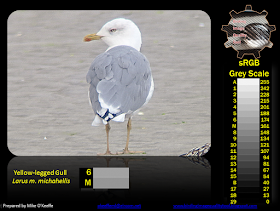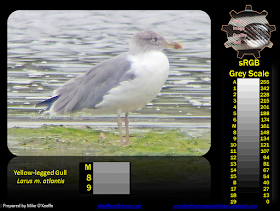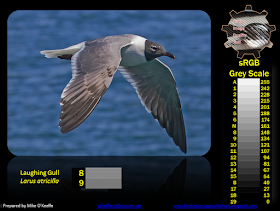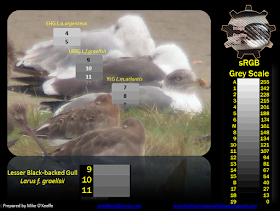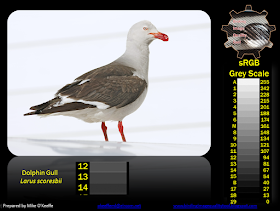The Kodak Grey Scale is commonly used as a tool in gull identification. It is a luminance scale with just 20, equally spaced increments, or levels between white and black. For birds in the hand it is a very useful scale. The human eye is good at making accurate direct (or local) tonal comparisons, so by placing a grey scale card directly on top of a grey mantle or wing feather of a gull we can easily make this direct comparison and assign a Kodak grey scale number to that tone. Crucially, this can be done irrespective of ambient light quality because the lighting at that point on the bird matches the lighting on the card. Table 3 in page 26 of Gulls of the Americas by Howell and Dunn lists the typical Kodak grey scale numbers for various gull species and taxa. These numbers are quoted elsewhere throughout the gull identification literature, so this has become a recognised standard in gull research.
A Digital Grey Scale Equivalent
It is very simple to make a comparable grey scale for digital images. We know that black has a luminance of 0 and white a luminance of 255. So we need only space 18 tonal increments evenly between these two points to make an accurate scale for use within the digital sphere. From this point on however things get progressively more complicated. The problem we have of course is how to accurately superimpose our grey scale into each of our digital images. The tonal levels in our images afterall are subject to a range of variables and it can be a real challenge to accurately depict individual tones.
We may be able to assign say a Kodak grey number of exactly 8.0 to a specific feather of a Laughing Gull (
Larus atricilla) by comparing it to a Kodak grey scale card in the hand. If we then were to photograph the bird moving about in various lighting settings we could quickly find that this specific feather is capable of varying in luminance level from near 0 (19 in our scale) when say the bird is in deep shade, to near 255 (0 or A in our scale), were the sun to reflect brightly off the feather for instance ... and every tonal level in between.
In the example below the mantle of this Laughing Gull is a shade darker perhaps than it appeared in life and this is simply due to the exposure and/or brightness settings of the image. Brightening the image just slightly would resolve this discrepancy. The European Herring Gull (
L. argentatus race
argenteus) behind it is also displayed a shade too dark and may also fall into line with the help of some brightening. To further compound the problem the choice of sample point is critical. Sampling a shaded part of the scapulars of the Herring Gull results in a grey scale value of 12, i.e. darker than the Laughing Gull sample. We would expect a grey scale level of between 4 to 5 for
L. a. argenteus based on the Kodak scale and of course we can see without even having to sample that overall the Herring Gull is on the whole paler than the Laughing Gull, as it should be. So a bad choice of sample point renders this method ineffective.
So we have identified a few confounding factors that would need to be resolved in order to apply the grey scale method to a digital image.
These include:-
- Ambient lighting quality
- Image exposure quality
- Image brightness and contrast settings
- Choice of sampling point
 Brightness, Contrast and Dynamic Range
Brightness, Contrast and Dynamic Range
Image brightness is determined by camera exposure settings and also by the processor during the output of the final image. Contrast is influenced by scene lighting and dynamic range, but also by exposure and again the camera's processor when outputting the final image. These elements have the strongest influence on the accuracy of tones in our images. We can adjust brightness, contrast and use other tonal adjustment tools both in RAW and when post-processing images but we have no way of matching tones exactly without some form of reference.
Our eyes have an amazing dynamic range (the range of luminance which our eyes can adapt to). This means that we could be gauging the mantle colour of a gull against a Kodak chart under almost any lighting conditions and we would make a pretty good job of it. Cameras do not have the same dynamic range as our eyes. Let's say for example we take an image on a very bright day with broad dynamic range. In that instance some of our tonal range may have been lost due to clipping. The pale grey on the mantle of a Herring Gull may be blown and appear white in an image. Alternatively the black of the wing may not appear pure black and this might influence the accurate capture of a species like Great Black-backed Gull (
Larus marinus) or Kelp Gull (
Larus dominicanus). With bright sunlight and broad dynamic range the contrast between shadows and highlights is also enhanced. The mid-tone range is diminished which can obscure the correct tone of a mid-toned gull species.
Ambient Light and Reflectance
What we are trying to measure here specifically is the reflectance of these feathers. The camera is equipped with an on-board light meter and this is quite an accurate instrument. The problem for us is that the light which the meter measures from our subject is reflected light - i.e. a combination of the ambient lighting of the scene and the reflectance of the feather.
Furthermore automatic exposure is based on metering and the exposure is intended for a reflectance of approx. 18% grey. Put another way, camera exposure technology is still pretty unsophisticated - by assuming everything in the world is this pale grey it is not too surprising that tones are often out of step with reality. For more on metering see
HERE.
If we want to get at the true reflectance of the feather we need to decouple ambient light from reflectance in our measurement. The only way to do this is to measure the ambient light separately and correct the image brightness based on that. For this we either use a light meter or a grey card.
Lighting and Perspective
In reality it can be very difficult to obtain the exact light reading we are after. Considering that we are dealing with a three dimensional subject where even the slightest change in the angle between the light source, the subject and camera will influence tone, this is not an easy thing to get right. We also have to consider that an exposure calibration will only correct for the lighting in a certain plane within the image. If we need to compare a number of subjects in the same image, all at different distances and facing the light source from different angles, the lighting will vary in all these locations. I have illustrated this point in an earlier posting on
Lighting and Perspective as also shown by experiment below.
I have studied lighting and perspective in more detail
HERE.
Sample Point
A spot sampling technique is explored
HERE. Knowing where to sample is the problem. Immature gulls begin to accumulate adult-like plumage from their 1st winter. The mantle feathers are the first to develop large areas of grey and being positioned at the highest point on the body are also the most reliably lit so this would tend to be the best place to sample. Take a look at the collection of images at the end of this post. It should be obvious that the upper mantle is the most consistent location to obtain an appropriately representative grey scale sample.
Grey Scales Versus Hues
Note again the grey scale is a luminance scale only so colour hue and saturation are irrelevant in this comparison. Clearly hue does have a role to play in gull identification but not for this particular analysis. If you are finding the subtle differences in hue between gulls a little jarring simple convert your images to grey scale and compare them along the grey scale in that way. I haven't done that here because I want to specifically draw attention to the fact that most gulls are not grey as such but a range of low saturation blues and browns. These subtle colours may turn out to be just as important in ID terms as the luminance level but shall be treated separately.
In Summary
Clearly, with the variables we are dealing with, trying to accurately depict and then measure the upperparts tones of gulls is a real challenge. For the best results we need bright but overcast conditions, we need to obtain a good exposure without clipping and we need to carefully measure and correct for the ambient light using a grey card or handheld light meter. Last but not least, our choice of sample point is crucial. We need to avoid the influence of bright reflection and shadow, and if we hope to compare different subjects in the same image we must ensure we sample from very similarly lit points. The upper mantle would seem to be the best location in general to sample from.
For more on Grey Scales and Gulls...
PART 2
PART 3
Field Guides - Photographs Versus Illustrations
Lastly a comment on photos versus illustrations. I find the illustrated plates in Malling, Olsen and Larsson's Gulls of Europe, Asia and North America easier on the eye and easier to interpret than the photographic plates in either of these two leading gull reference guides. Lighting, exposure and white balance can be very distracting in many photographs, especially when one's eye is tuned to look for these image quality parameters. It can be hard in some cases to readily appreciate the correct tone of a bird's upperparts from a photograph particularly when faced with these additional cues. Furthermore a grey scale contains no hue and yet clearly gull species differ slightly in terms of the hue of their upperparts, with some species showing warm earthy tones and others tending towards the colder blue-greys. For me Larsson's excellent plates convey both the subtle luminance and subtle hue more effectively than a range of photographs can. So, my preference in this case would be for the illustrations.
